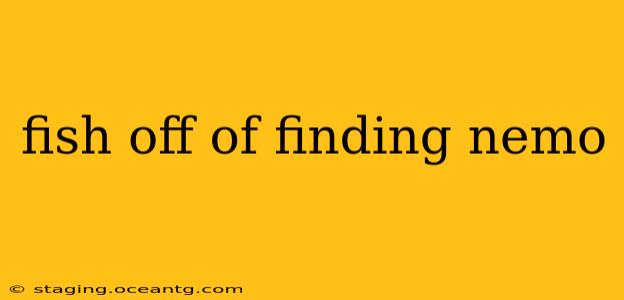Finding Nemo, the beloved Pixar animation, introduced us to a vibrant underwater world teeming with diverse marine life. While the story focuses on Marlin and Nemo's journey, the film is rich with a supporting cast of memorable fish, each with unique characteristics and ecological roles. This article explores some of the most iconic fish featured in Finding Nemo, delving into their real-world counterparts and the fascinating roles they play in their ocean habitats.
What Kind of Fish is Nemo?
Nemo is an ocellaris clownfish, also known as a percula clownfish. These small, brightly colored fish are instantly recognizable by their bright orange bodies and three white bands edged with black. They're famously known for their symbiotic relationship with sea anemones, finding protection within their stinging tentacles while simultaneously helping to clean the anemones. In reality, ocellaris clownfish are found in the western Pacific Ocean, inhabiting coral reefs. Their striking appearance and captivating behavior make them a popular choice for home aquariums, but it’s crucial to source them responsibly to avoid harming wild populations.
What Other Fish Are in Finding Nemo?
Finding Nemo boasts a diverse cast of characters, each representing different species. Let's explore a few:
Dory: The Regal Blue Tang
Dory, Nemo's forgetful but loyal friend, is a regal blue tang. These beautiful fish are characterized by their vibrant blue bodies and striking yellow tails. Regal blue tangs are found in the tropical waters of the Indo-Pacific Ocean, and like many other fish featured in the film, are popular in the aquarium trade. They require specific care to thrive in captivity, highlighting the importance of responsible aquarium ownership.
Gill: The Moorish Idol
Gill, the wise and experienced tank inhabitant, is a Moorish idol. Easily recognizable by their distinctive black and white striped bodies and long, flowing dorsal fin, these fish are found in the tropical Indo-Pacific Ocean. Sadly, Moorish idols are quite sensitive and difficult to keep in captivity; they're prone to stress and disease, making them less common in home aquariums.
Bruce: The Great White Shark
Bruce, the vegetarian great white shark, might be the most memorable and unexpected character. While the film portrays him comically overcoming his predatory instincts, great white sharks are apex predators in the ocean's ecosystem, playing a critical role in maintaining the balance of marine life. Great whites are found in coastal waters around the world, known for their impressive size and powerful jaws. Unfortunately, they face significant threats from overfishing and habitat destruction.
What Types of Fish Live in Coral Reefs?
Coral reefs are incredibly biodiverse ecosystems, supporting a vast array of fish species. Finding Nemo accurately depicts this, showcasing fish of many different shapes, sizes, and colors. Beyond the main characters, we see numerous reef fish, including angelfish, butterfly fish, parrotfish, and surgeonfish, all integral parts of this complex and delicate ecosystem. The diversity highlights the vital importance of coral reef conservation.
Are the Fish in Finding Nemo Realistic?
While Finding Nemo takes creative liberties for storytelling purposes (talking fish, for instance!), the film's portrayal of fish species and their behaviors is largely accurate. The depiction of the symbiotic relationship between clownfish and sea anemones, for example, is scientifically sound. The movie successfully blended entertainment with educational aspects, fostering an appreciation for marine biodiversity.
How Does Finding Nemo Promote Ocean Conservation?
Finding Nemo's success inadvertently brought increased awareness and attention to coral reefs and the threats they face. While the film doesn’t explicitly focus on conservation, its captivating visuals and relatable characters sparked interest in marine life and the importance of protecting these fragile ecosystems. The movie's popularity has undoubtedly contributed to a greater understanding and appreciation for ocean conservation.
This exploration of the fish from Finding Nemo reveals not just a charming cast of characters, but also a fascinating glimpse into the biodiversity and complexities of the ocean's ecosystems. Their portrayal highlights the need for responsible interaction with marine life and underscores the importance of ongoing conservation efforts.
